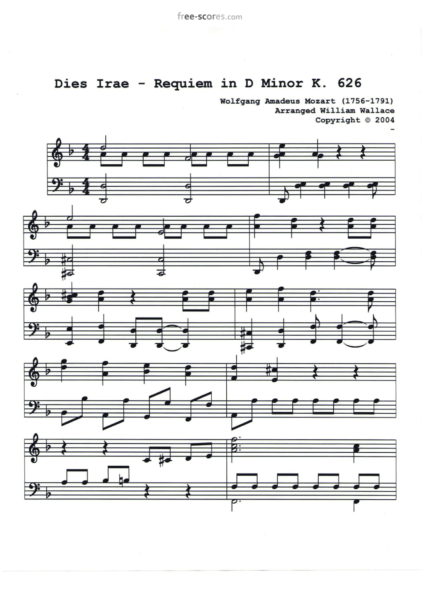
日本人が大好きなクラシックの作曲家、「モーツァルト」。
そんなモーツァルトの中でも、珍しく明るくない曲がいくつかあります。
今回紹介する「レクイエム」もその中の一つです。
実はこの曲は、すべてモーツァルトが作ったわけではありません。
モーツァルトはこの曲を完成する前に亡くなってしまいます。
この曲は彼の弟子が完成させている曲なのです。
とはいえ、完成度は素晴らしく、このレクイエムは、クラシックの中で3大レクイエムとして数えられるほど有名な曲になっています。
そもそもレクイエムとは
Wikipediaには以下のように記載されています。
1.死者の安息を神に願うカトリック教会のミサ。死者のためのミサ(羅: missa pro defunctis)。聖公会においても行われる。
2.上記のミサで用いる聖歌。完全ミサ曲のひとつ。またそれに想を得て作られた楽曲。「死者ミサ曲」、「死者のためのミサ曲」などと訳される。「鎮魂歌」(ちんこんか)、「鎮魂曲」(ちんこんきょく)と訳されることもあるが、レクイエム自体には「鎮魂」の意味はない。
キリスト教徒ではない私からすれば、よくわからない単語が並んでいます。。。。
単語をひとつずつ紐解いていきましょう。
まず、カトリック教会とはキリスト教の宗派の一つです。仏教でも浄土宗や日蓮宗などいろんな宗派がありますね。キリスト教にも同じようにいくつかの宗派があり、カトリック教会とはその中の一つです。
ここではあえて「カトリック教会」と指定しています。
これはあくまでも他の宗派(新興宗教などの諸宗派は除く)にはレクイエムがないことを表すためです。
キリスト教には「プロテスタント」や「ギリシア正教」などがありますが、これらの宗派にはレクイエムはありません。
次にミサとはカトリック教会の典礼儀式です。
典礼儀式とは宗教的な儀式のことをいいます。
「宗教的な儀式」と言われても、私も含め、どの宗教にも属していない人が多い日本人にはピンとこない方も多いでしょう。
少し違いますが、社会的な儀式として日本で一般的なものは「成人式」や「入学・卒業式」がありますね。
このような「式」の、宗教的な意味をもつものが典礼儀式です。
まとめると、死者の安息を神様に願う宗教的な儀式で使う歌を「レクイエム」というわけです。
ここで注意していただきたいのは、レクイエムは「神様に願う」ものであって「死者に対する歌」ではないということです。
よく「レクイエム」=「鎮魂歌」と訳し使われていることがありますが、これは正式には間違っていることがわかりますね。
楽譜紹介
では本題に戻って、無料の楽譜を紹介していきます。
原曲がピアノの曲ではないため、ピアノの楽譜として無料で提供しているものは殆どありませんでした。
そのなかでも、おすすめできる楽譜が2つしかなかったので、今回はその2つだけ紹介します。
またいい無料楽譜が見つかれば、更新していきます。
楽譜の画像をクリックするとリンク先へ移動します。
リンク先でダウンロードや印刷が出来ます。
ダウンロードして印刷したり、iPadなどのタブレットで見ながら演奏してみましょう。
レクイエム ニ短調 K.626(モーツァルト)_無料ピアノ楽譜①
最初に紹介するのは初心者向けのピアノ楽譜です。
比較的やさしい難易度で作られており、初心者の方でも少しの練習で演奏できる楽譜になっています。
無料楽譜なので文句は言えませんが、楽譜記号など、もう少し細かいところも記載してほしかったところです
難易度は初級です。

レクイエム ニ短調 K.626(モーツァルト)_無料ピアノ楽譜
レクイエム ニ短調 K.626(モーツァルト)_無料ピアノ楽譜②
次の楽譜はこちらです。
この楽譜はピアノのパートを伴奏として作られており、別パートでオペラの声部が書かれています。
弾き語りには向かない曲ですが、伴奏として演奏する場合はこちらの楽譜がおすすめです。
※楽譜の中でK.636と記載してありますが、おそらくK.626の間違いです。

出典

コメントを残す